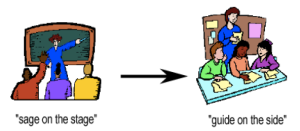When I first heard of the flipped classroom I thought that it had potential but, at the end of the day, it was still homework. There is definite value in creating videos and other content and making it available for our learners, however, getting them to view it before a lesson is not always realistic. There are a number of reasons for this: they may not have internet access at home, they are busy with other commitments and don’t make it a priority or, they are simply lazy. This has meant that we have had to adapt the original concept or come up with strategies to make it work.
A strategy
My amazing colleague, Linda Rubens, trained one of her classes by giving rewards (yep, lollies!) to those learners who had completed their flipped learning the night before. After a few times of doing this, she had the class mostly trained. She started by lining the class up outside and asking who had completed the flipped learning. Those who had could enter the class and Linda quizzed them to make sure they had completed it. They then got lollies. Those still outside could see what was happening but had to stay out in the cold until Linda was ready for them to come into the warm classroom! According to Linda, the feeling of missing out on something motivated them to do what was required the following time.
Adapting
Another way to approach flipped learning is to make videos, keynotes, iBooks and blog posts available on the school LMS and ask learners to view/read them at home but if they don’t, they view/read through them the next day in class. The expectation is that they will engage with the information at their own pace and the teacher will not be lecturing in front of them for the majority of the lesson. Linda has done this for essay writing tests and it has enabled most learners to work on their own while she works with the less able to answer any questions and further clarify concepts. I found that if I posted a video on our class Facebook page, my kids were more likely to view than if it was posted on the LMS.
This is the true beauty of the flipped classroom, it allows the teacher to stop being the ‘sage on the stage’ and to be the ‘guide on the side’.
Being the ‘guide on the side’ has many benefits.
1. You can personalise/differentiate easily. A learner can work at their own pace and the teacher can work alongside and give feedback or feedforward as and when needed.
2. You can build positive relationships with learners. When discussing work, there is time to ask about how a rugby game went in the weekend or find out about other interests. Learners generally love it when you show an interest in them and they are likely to feel more positive about your class.
3. When roaming you are able to discover common areas of need or common problems. You are then able to deliver mini lessons to revise or clarify concepts that learners are not understanding.
Flipped learning is definitely an improvement on how I used to teach and it’s great to have been able to adapt the way in which it is used so that it is successful for our learners. It’s important not to give up on an idea such as this just because it doesn’t quite fit. Adaptability and creativity are essential.
If you need more information, or want to get started with creating your own flipped classroom check out this presentation:

I enjoyed reading this Chris. My “how we have grown”! It is a question of being prepared and then just doing it. The students easily adapt , contrary to the view of gainsayers, to flipped learning.
LikeLiked by 1 person
Reblogged this on mrsrubens.
LikeLike